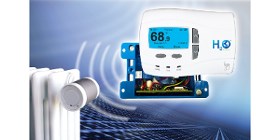H2O Degree, manufacturer of advanced two-way wireless submetering systems for tenant billing, leak detection, utility conservation, and building automation system integration in multi-family facilities introduces the HCH0104 Hydronic Radiator Contro System providing wireless control of energy-harvesting radiator actuators. This new capability combines H2O Degree’s M5445x programmable, wireless Smart Thermostat, a Zigbee to EnOcean wireless bridge interface and one or more HCV0104 wireless radiator actuators per unit. The wireless radiator actuators feature EnOcean energy harvesting technology, eliminating the need for cable connections or batteries.
The system is ideal for multi-family properties where they have a central plant hydronic heating system generating hot water to radiators throughout the property to deliver heat to each apartment. The H2O Degree HCV0104 Wireless Radiator Actuator mounts directly onto thermostatic radiator valve bodies where it controls the room temperature, based on signals from the HCH0104 Smart Thermostat and Zigbee to Enocean Bridge. The HCV0104 Wireless Radiator Actuator contains a thermoelectric harvesting module, internal energy storage, an electromechanical valve actuator, a radio module, and microcontroller. The HCH0104 Smart Thermostat and Bridge communicates wirelessly with the H2O Degree cloud server.
Property managers can view all the thermostat values such as set points and temperature readings on H2O Degree dashboards and adjust units individually or adjust all units site-wide. Residents can be given access to their in-unit thermostat through a web-based portal or mobile application that allows remote control of their temperature setpoints that wirelessly actuate the radiator valves. In addition to the advanced control, the system can be used to generate utility data to bill tenants for their specific usage of energy for heating through the run-time feature in the thermostat. This not only allows property managers to pass the costs on to tenants but creates an incentive for behavioral change among tenants to conserve energy.


